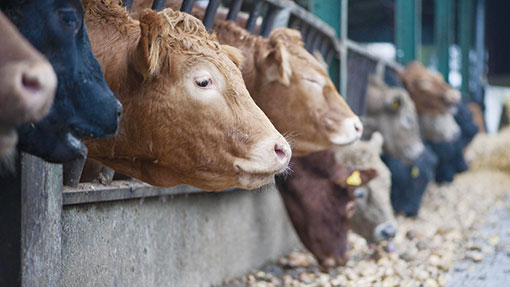Advice on reducing beef cow ration costs

Use all your home-grown feed, analyse every bit of it and keep rations simple.
That is the advice beef nutritionist David Hendy is giving to his customers as he tackles the cost of store and finishing diets. And although it is essential to be aware of forage costs, the 20-25% drop in the price of cereals and protein gives scope for worthwhile savings.
See also: Find out how other farmers are using co-products in beef and dairy rations
Mr Hendy says: “Forages are good quality and clamps are full. The three key components of a ration are forage, energy and protein, but if the forage and energy can be home-grown it’s the best way to keep beef feed costs down.”
Home-grown feed
Mr Hendy says every beef producer should be looking at the feed produced on farm and how it can best be used as a starting point.
With ample supplies of grass silage and the likelihood of a good maize crop there are opportunities to ease feed costs.
“But beef producers should analyse every single bit of forage on the farm and know exactly what feed value they’re working with – and then look at their cereal and protein needs. Keep it simple,” adds Mr Hendy.
“There are lots of opportunities to use by-products and waste feeds this season, with plenty of good deals about. Stock-feed potatoes are readily available – often for just the haulage cost.
“By-product feeds must be bought at the right price in terms of unit cost of energy and protein, but with ample forage and lower cereal prices, sellers of by-products know they’ve got to be competitive on price this year,” he says.
With potatoes as an additional energy source in a ration, Mr Hendy says they can replace cereals when used on a 5:1 basis. He says they will improve ration palatability if the silage is dry and also help to increase intakes, as will other moist feeds.
Some waste feed prices have been “dropping like a stone” according to beef feed advisers. Bread is now about £90/t, and with barley at £115/t and wheat at £125/t, it makes cereals look like a good-value energy source for the coming winter.
Cost savings
Savings on beef feed costs need only be small to make a big difference. For example, saving 30p a head a day on feed costs on a unit carrying 200 finishing cattle produces a monthly benefit of £1,500.
Phil Holder, of liquid feed suppliers ED and F Man, says beef producers should consider treating straw to improve feed value and palatability.
“Treating with molasses-based liquid feeds also enables protein sources to be introduced to make low-cost straw a useful base for beef diets,” says Dr Holder.
Beef specialist Lachlan MacLachlan of Mole Valley Farmers is confident beef producers can make savings of 15-20% on their rations compared with this time last year.
“A year ago, average finishing costs were just under £2 a head a day – that figure is now more like £1.60-1.70. Barley is down about £50/t compared with last year, but as well as the lower input costs, there’s a lot of potential for beef producers to look at how they are putting their diets together.
